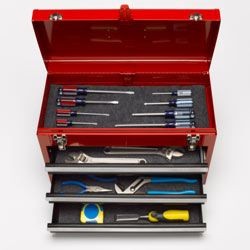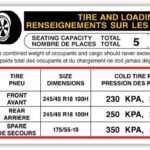Changing your car battery might seem daunting, but with the right tools and a bit of know-how, it’s a task you can easily tackle yourself. Before you jump under the hood, gathering the correct tools is crucial for a smooth and safe process. One of the most frequently asked questions when preparing for this DIY task is: “What Size Wrench For Car Battery terminals?”. Let’s dive into the specifics of wrench sizes and the other essential tools you’ll need to replace your car battery effectively.
Before we talk wrenches, if you’ve already prepared a baking soda and water solution to clean corroded terminals, ensure it’s within reach. This solution is invaluable for thoroughly cleaning terminal cables. If not, quickly mix some and have a clean paintbrush ready to apply it later.
 Toolbox with wrenches and tools needed for car battery replacement, highlighting the importance of having the right size wrench
Toolbox with wrenches and tools needed for car battery replacement, highlighting the importance of having the right size wrench
Determining the Right Wrench Size for Car Battery Terminals
When it comes to disconnecting and reconnecting your car battery cables, the wrench size is critical. Battery terminal cables are secured to the battery terminals using nuts and bolts. Therefore, you’ll need a wrench that fits these nuts snugly to loosen or tighten them effectively.
Socket Wrench and Sizes:
For most car batteries, the terminal bolts typically require either a 10 mm or 12 mm socket. These are the most common sizes you’ll encounter. It’s advisable to have both sizes in your toolkit to ensure you’re prepared for either. A socket wrench set is highly recommended as it provides versatility and ease of use.
Alternative Wrenches:
While socket wrenches are ideal, you can also use other types of wrenches if you don’t have a socket set readily available:
- Crescent Wrench (Adjustable Wrench): An adjustable wrench can be adapted to fit various nut sizes, making it a versatile tool. Ensure it’s securely tightened on the nut before applying force to avoid slippage and potential damage.
- Adjustable Pliers (Vise-Grip Pliers): Similar to an adjustable wrench, pliers can grip and turn nuts and bolts. However, they might be less precise than a wrench and could potentially damage the corners of the nut if not used carefully.
Using Two Wrenches for Tightening and Loosening:
In some cases, you might need to use two wrenches. One adjustable wrench or a pair of adjustable pliers can be used to hold the bolt head in place while you use another wrench (socket, crescent, or adjustable) to turn the nut. This is especially helpful when dealing with stubborn or corroded bolts.
Additional Essential Tools for Car Battery Replacement
Beyond the correct wrench size, several other tools will make the battery replacement process smoother and safer:
1. Hammer:
While it might seem unusual, a hammer can be useful. Gentle taps with a hammer can help loosen a stubborn terminal cable that’s stuck to the terminal post due to corrosion or tight fit. Always use gentle taps to avoid damaging the battery or terminals.
2. Battery Terminal Cleaner:
A dedicated battery terminal cleaner is an inexpensive but invaluable tool. It’s designed to remove corrosion from both the terminal posts and the inside of the cable clamps. Using a terminal cleaner ensures a clean and solid connection with your new battery, improving performance and longevity. Alternatively, a narrow metal wire brush can also be used, but a terminal cleaner tool is often more effective and easier to handle.
3. Corrosion Protector Spray:
Prevention is always better than cure. After cleaning your terminals and installing the new battery, apply a corrosion protector spray. This spray creates a protective barrier that helps prevent the buildup of corrosive sulfates in the future, extending the life of your battery terminals and cables.
4. Safety Gear: Gloves and Goggles:
Safety should always be a priority when working with car batteries. Batteries contain sulfuric acid, which is corrosive and can cause burns. Always wear sturdy gloves and safety goggles to protect your hands and eyes from acid and debris.
5. Rags or Cloths and Plastic Container:
Keep rags or cloths handy to wipe away any spills or mess, especially when cleaning terminals. A plastic container is useful for organizing your tools and keeping them within reach while you work.
Step-by-Step Guide to Using Your Wrenches and Tools
Now that you know “what size wrench for car battery” and the other tools you’ll need, let’s outline how to use them during a battery replacement:
- Preparation and Safety First: Put on your safety goggles and gloves. Ensure your car is turned off and parked on a level surface.
- Locate the Battery Terminals: Identify the positive (+) and negative (-) terminals of your car battery.
- Disconnect the Negative Terminal First: Using the correct size wrench (likely 10mm or 12mm), loosen the nut on the negative terminal cable. Once loose, carefully remove the cable and tuck it away from the battery terminal to prevent accidental contact.
- Disconnect the Positive Terminal: Repeat the process for the positive terminal cable, again using the appropriate wrench size.
- Remove the Battery Hold-Down: Depending on your car, there might be a clamp or bracket holding the battery in place. Use a wrench or socket to loosen and remove this hold-down.
- Lift Out the Old Battery: Carefully lift the old battery out of the battery tray. Batteries can be heavy, so lift with your legs and keep your back straight.
- Clean Battery Terminals and Cable Clamps: Use the battery terminal cleaner or wire brush to thoroughly clean any corrosion from the battery posts and the inside of the terminal cable clamps. Apply the baking soda and water solution if corrosion is heavy, then clean again with the brush. Wipe clean and dry.
- Install the New Battery: Place the new battery in the battery tray.
- Reconnect the Positive Terminal First: Attach the positive terminal cable to the positive terminal and tighten the nut with the correct size wrench. Ensure it’s snug but not overtightened.
- Reconnect the Negative Terminal: Attach the negative terminal cable to the negative terminal and tighten the nut.
- Secure the Battery Hold-Down: Reinstall and tighten the battery hold-down clamp or bracket.
- Apply Corrosion Protector: Spray a corrosion protector on the terminals and cable clamps to prevent future corrosion.
Conclusion
Having the right tools, especially knowing “what size wrench for car battery,” is essential for a successful DIY battery replacement. Typically, a 10mm or 12mm wrench will do the job for most car batteries. Alongside wrenches, tools like a terminal cleaner, corrosion protector, and safety gear are crucial for a safe and effective process. By preparing properly, you can confidently replace your car battery and ensure your vehicle runs smoothly. Remember to always prioritize safety and double-check connections for optimal performance.
